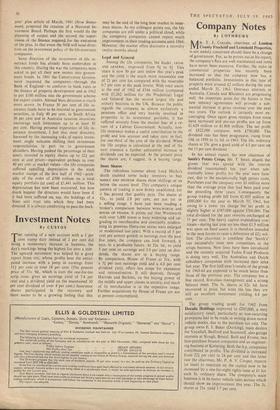Investment Notes
By CUSTOS
HE opening of a new account with a 1 per I cent stamp duty instead of 2 per cent did bring a momentary increase in business, the day's markings being the highest for over a year. The upward movement was helped by a good report from GEC, whose profits beat the antici- pated increase with a jump in earnings from I If per cent to over 18 per cent. (The present price of 51s. 9d., which is cum the one-for-ten scrip issue, gives an earnings yield of 7.4 per cent and a dividend yield on the maintained 10 per cent dividend of over 4 per cent.) Insurance shares participated in the recovery and there seems to be a growing feeling that this
may be the end of the long bear market in insur- ance shares. As my colleague points out, the life companies are still under a political cloud, while the composite companies cannot expect much improvement in their trading accounts until 1964. However, the market often discounts a recovery twelve months ahead.
Legal and General
Among the life companies, the leader, LEGAL AND GENERAL, improved from 9f to 9tt. This
share is now 30 per cent below this year's peak and the yield is the much more reasonable one of 21 per cent (as compared with the miserable 0.7 per cent at the peak levels). With total assets at the end of 1962 of £544 million (compared with £1,262 million for the Prudential) Legal and General has the second largest life and annuity business in the UK. Because the public regards the company as almost exclusively a pensions office and very heavily involved in properties in its investment portfolio, it has suffered severely from the market fear of a re- turn of a Labour Government. Actually, non- life insurance makes a useful contribution to the profit and loss account and takes care, in fact, for one-third of the cost of the dividend. When the life surplus is calculated at the end of the next triennial a further substantial increase in dividends can be expected. At the present priCe the shares are, I suggest, in a buying range.
Store Shares
.The ridiculous rumour about Lord Marks's death enabled some lucky investors to buy MARKS-*AND SPENCER shares three shillings or so below the recent level. This company's unique pattern of trading is now firmly established, for it has proved that quality pays. The shares at 92s., to yield 2.8 per cent, are not yet in a selling range. I have just been reading a broker's comparison between WOOLWORTH and HOUSE OF FRASER. It points, out that Woolworth with over 1,000 stores is busy widening and up- grading its merchandise and constantly modern- ising its premises (forty-one stores were enlarged or modernised last year). With a record of 5 per cent per annum growth in earnings over the past five years, the company can look forward, it says, to a profitable future. At 52s. 9d., to yield 5 per cent on earnings and 3.4 per cent on divi- dends, the shares are in a buying range. By comparison, House of Fraser at 31s., with a 5} per cent earnings yield and a 4.8 per cent dividend yield, offers less ,scope for expansion and rationalisation. It still depends, through Harrods and Barkers, on the buying power of the middle and upper classes in society, and much of its merchandise is in the expensive range. Further acquisitions by House of Fraser are not at present contemplated.






























 Previous page
Previous page